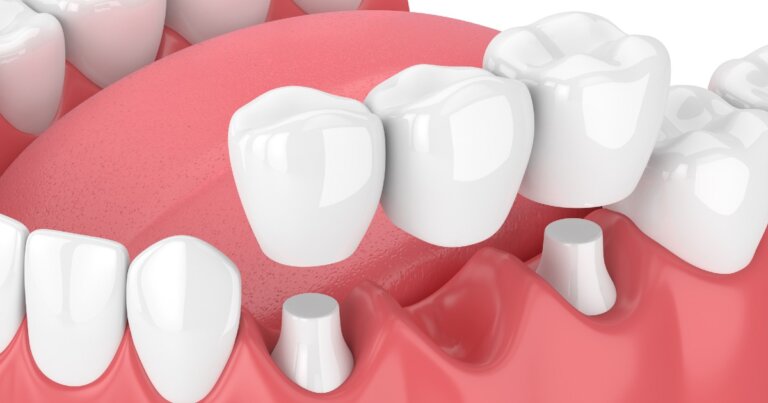Dental Bridge Home Care Instructions

What You Should Do After Receiving Your Dental Bridge
Dental bridges, also known as fixed partial dentures, literally bridge the gap created by one or more missing teeth. After receiving your dental bridge, it is important to follow these post-visit instructions to ensure an uneventful recovery period.
If you have not had your dental bridge fabrication appointment yet, please read our pre-visit instructions.
Oral Hygiene
- Brush At Least Twice A Day: Conventional wisdom says that you should brush at least twice a day; once in the morning and once before you go to bed. Two times a day is a good rule of thumb. But ideally, you should brush right after a meal. This is to maximize the amount of time your teeth stay clean between meals.
- When You Cannot Brush Your Teeth, Rinse With Water Or Mouthwash: It is sometimes not practical to be brushing after every meal. You may be busy at work or at school during your day and cannot find time to brush or floss. If this is the case, at least rinse with water or mouthwash to get as much food debris and taste out of your mouth. This will help prevent recurring cavities under your new bridge. One brand of mouthwash that we highly recommend is Crest Pro-Health Densify Anticavity Fluoride Mouth Rinse.
- Consider Upgrading Your Toothbrush: Ensure you are using a soft-bristled toothbrush to clean the area around your dental bridge, as they are gentler on the tooth and less likely to cause damage or irritation to the gum tissue around it. One brand of toothbrush that we highly recommend is the Curaprox CS5460 Ultra Soft Swiss Toothbrush. Also consider upgrading to an electric toothbrush, which can be more effective at removing plaque and bacteria around your dental bridge and surrounding teeth. One brand of electric toothbrush that we highly recommend is the Philips Sonicare Protectiveclean 6100.
- Floss Daily: Flossing is critical to remove plaque and food particles that may accumulate around and underneath your dental bridge. Ideally you should be flossing every time you brush, but once a day is the bare minimum. We recommend Oral-B Super Floss.This floss features a unique three-part design that makes it easy to clean around braces, bridges, and other hard-to-reach areas..
- Buy A Water Flosser: We highly recommend you purchase a Water Flosser and to use it daily in addition to regular flossing; the Water Flosser will flush out debris missed by floss and toothbrush. Ideally you should be water flossing every time you brush, but once a day is the bare minimum. One brand that we highly recommend is the Waterpik Aquarius Water Flosser
- Use An Anticavity Antibacterial Mouthwash Daily: Rinse your mouth with a high fluoride, anticavity mouthwash specially formulated to reduce the risk of cavities forming under around your dental bridge and to freshen your breath. Ideally you should be rinsing with mouthwash every time you brush, but once a day is the bare minimum. One brand of mouthwash that we highly recommend is Crest Pro-Health Densify Anticavity Fluoride Mouth Rinse.
- Use An Anticavity Toothpaste: Be sure to use a toothpaste that has a unique formula that is high fluoride and will minimize the risk of new cavities forming around your new dental bridge, and promote gum health. One brand that we highly recommend is the Colgate PreviDent 5000 ppm Booster Plus Toothpaste.
Food
- You can eat any type of food like normal with your permanent dental bridge.
- You should avoid foods with highly refined sugars such as sugary drinks, candies, and sweet syrups. They increase your risk of cavities forming around your dental bridge.
Numbness
- Any numbness you’re experiencing from the local anesthetic will last approximately two to three hours. Until the anesthetic wears off, be careful not to drink hot liquids or bite your lip, cheek or tongue.
Difficult Jaw Opening
- Local anesthetic injections by their very nature cause injury to the muscles of the jaw, and can result in temporary difficulty opening your jaws wide, pain, and muscle spasm of the affected side. This is a condition called “myogenic trismus secondary to dental local anesthetic injection”.
- Follow this link to learn more about how to manage myogenic trismus at home.
Pain, Sensitivity And/Or Swelling
- It’s possible to temporarily experience hot and cold tooth sensitivity. This will go away within a day or two.
- You can brush your teeth using a desensitizing toothpaste like Sensodyne Rapid Relief Toothpaste.
- You are also welcome to use over the counter pain relievers such as ibuprofen (Advil) or acetaminophen (Tylenol). Ask your dentist what dosage is right for you, but if you do not have a pre-existing medical condition of allergies, 1000mg acetaminophen (Tylenol) with 600mg ibuprofen (Advil) every 4-6 hours or as needed is a very powerful combination.
Visit Your Dentist For Regular Checkups And Cleanings
- If you find that your bite is uneven or the dental bridges feel high, contact us and we can adjust the bite free of charge.
- In addition to daily brushing and flossing at home, you should regularly visit your dentist. We recommend that you see your dentist at least once a year for a check-up and at least every 6 months for a dental cleaning. Your dentist will assess the health of your dental bridge as well as signs of dental decay or gum disease so that they can be treated early.
Have Questions?
- If you have any additional questions or concerns about your tooth bridges, please contact us.

